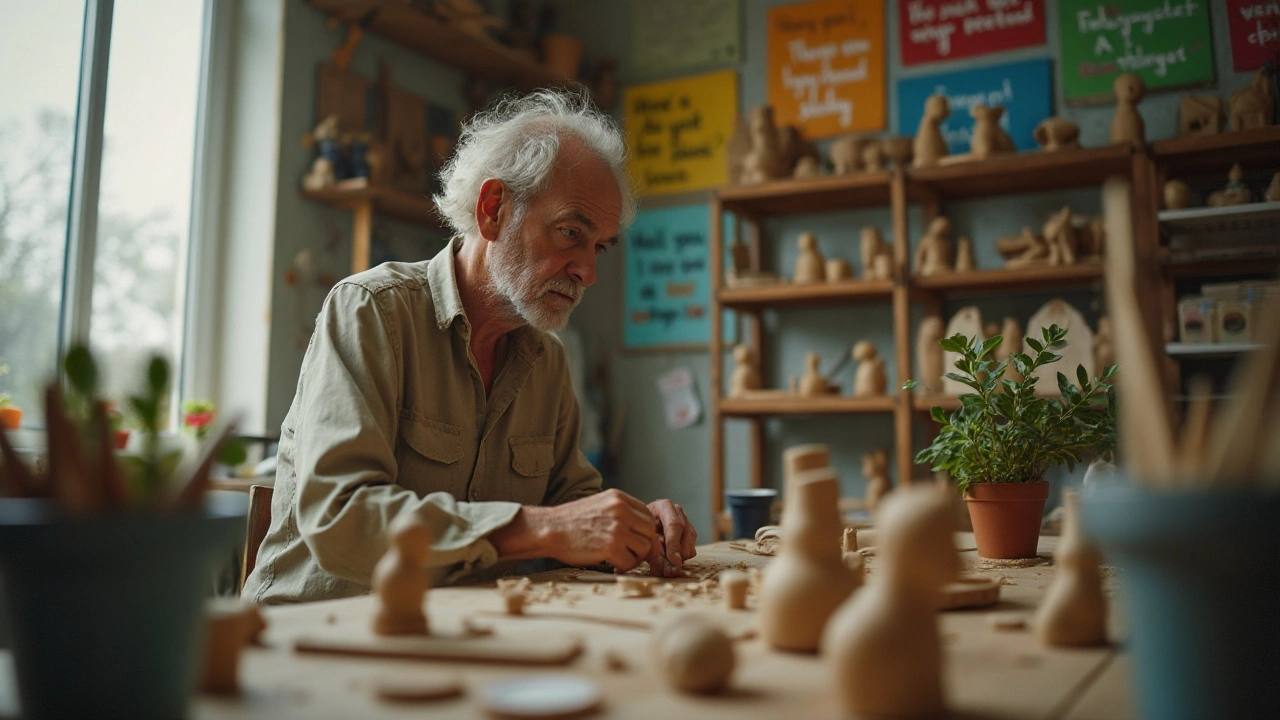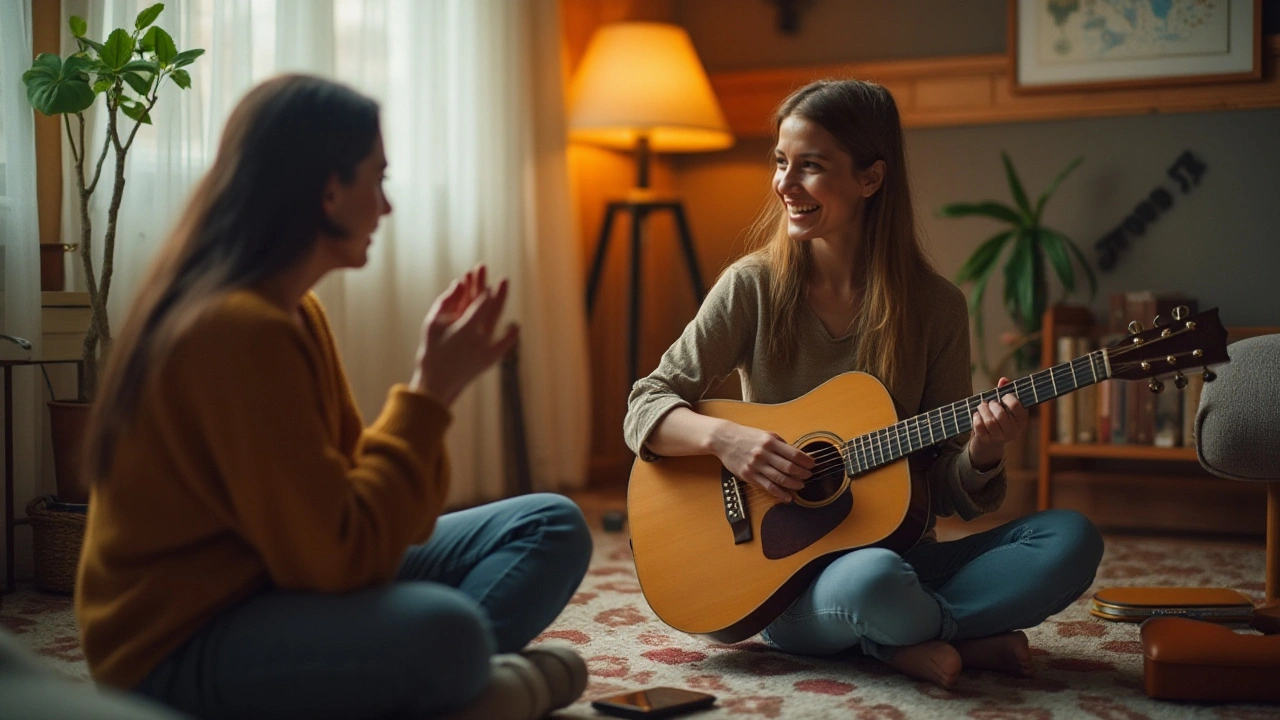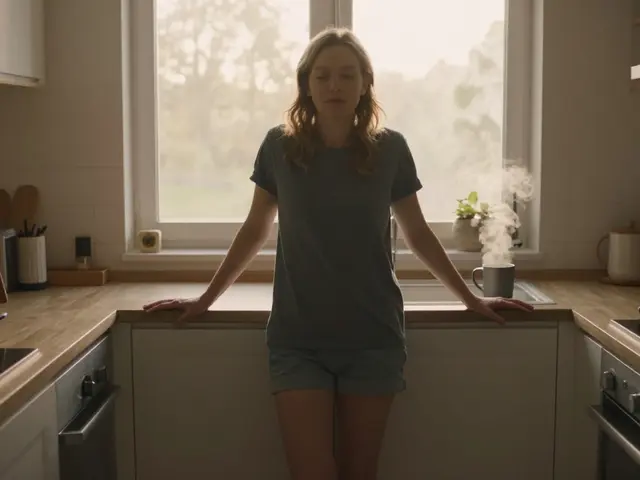
Creativity and therapy have always shared a unique bond, yet in recent years, this relationship has begun to receive the attention it deserves through Creative Arts Therapies. Imagine using art, music, dance, or drama as a means to foster healing, express emotions, and improve mental health. It's not merely about creating masterpieces, but rather about channeling one’s creative energy to unveil their inner world.
In this exploration of Creative Arts Therapies, we will look into different modalities such as art therapy, music therapy, drama therapy, and dance/movement therapy. These therapeutic practices are embedded with the philosophy that the process of creation is as vital as the end product, helping individuals to communicate feelings that might be difficult to express with words alone.
Throughout this article, you’ll discover how these therapies work, scientific support backing their efficacy, and practical tips on integrating creativity into everyday life. Let's embark on this enlightening journey where imagination meets healing.
- What is Creative Arts Therapy?
- Types of Creative Arts Therapies
- How Creativity Facilitates Healing
- Scientific Backing of Creative Arts Therapy
- Benefits on Mental Health
- Tips to Incorporate Creativity into Daily Life
What is Creative Arts Therapy?
Creative Arts Therapy is an umbrella term that encompasses various therapeutic approaches that utilize artistic expression as a key element in the healing process. Unlike conventional talk therapy, creative arts therapy engages individuals through creative mediums like visual art, music, dance, drama, and even literary arts. These modalities allow people to explore and express their emotions in a non-verbal manner, which can be particularly useful for those who find it challenging to articulate their feelings with words alone.
One notable aspect of creative arts therapy is its versatility. It can be tailored to suit individuals of all ages, from children to the elderly, and can address a wide range of issues including mental health disorders, trauma, stress, and chronic illnesses. According to the American Art Therapy Association, ‘art therapy is rooted in the belief that the creative process involved in artistic self-expression helps people to resolve conflicts, develop interpersonal skills, manage behavior, reduce stress, and increase self-esteem and self-awareness.’
These therapies are grounded in a rich history of combining the arts with healing practices. For example, art therapy as a formal profession began to take shape in the mid-20th century, influenced by the works of pioneers like Margaret Naumburg and Edith Kramer, who recognized the therapeutic potential of artistic expression. Music therapy has roots that stretch back to ancient cultures but found renewed scientific backing in recent decades, particularly in addressing conditions like PTSD and autism spectrum disorders.
Workshops and sessions often involve creating or engaging with art in a guided setting, where the end goal is not the creation of a perfect piece but to use the artistic process as a journey of self-discovery and healing. Clients might work on drawing or painting in art therapy, compose or listen to music in music therapy, move their bodies to rhythm in dance therapy, or even enact scenarios in drama therapy. These activities are often followed by reflective discussions with a therapist who helps the individual derive meaning from their creative work.
One of the attractive features of healing through art is that it can be incredibly inclusive. You don't need to be a skilled artist to benefit from these therapies. The process itself—whether it’s drawing abstract shapes, playing simple melodies, or moving to a rhythm—can facilitate emotional release and insight. Dr. Cathy Malchiodi, a leading authority in the field, states, ‘Many times the nonverbal languages of art and music speak when words fail, filling in what cannot be said in conversation alone.’
Creative arts therapy is not just confined to individual therapy sessions; it’s also increasingly used in group settings, offering communal healing experiences. Hospitals, schools, mental health facilities, and community centers are just some of the places that have integrated these interventions into their programs. In group settings, the shared creative process can help participants feel less isolated and more connected to others.
In summary, Creative Arts Therapy offers a holistic approach to healing that taps into the transformative power of the arts. Whether it's sculpting a piece of clay, strumming a guitar, or moving rhythmically, these therapies provide valuable tools for emotional expression, self-discovery, and mental wellbeing. By merging creativity with therapeutic practices, it opens new pathways for healing that traditional therapy alone might not offer.
Types of Creative Arts Therapies
The realm of creative arts therapy is vast and diverse, embracing multiple forms of artistic expression to facilitate healing. Each type offers unique avenues for emotional and psychological exploration while maintaining a common goal: improving mental health and well-being.
Art Therapy
Art therapy leverages the visual arts—drawing, painting, sculpture, and more—to promote personal development and emotional healing. It's not about creating a perfect piece of art but expressing feelings and experiences that might be challenging to convey verbally. Studies have shown that engaging in art can reduce stress and anxiety, enhance self-awareness, and even improve cognitive function. As art therapist Cathy Malchiodi notes,"Art speaks where words are unable to explain."
Music Therapy
Music therapy employs the power of sound to address emotional, cognitive, and social needs. Sessions might involve listening to music, playing instruments, songwriting, or even discussing lyrics. Music has a unique ability to evoke emotions, making it an effective medium for connecting with hidden feelings. Neurological studies reveal that music can alter brainwave patterns and improve neural connectivity, which is beneficial for people with various mental health conditions, including depression and PTSD.Drama Therapy
Drama therapy utilizes role-playing, storytelling, and improvisation to explore and solve personal and social issues. This therapy encourages individuals to step into different roles, allowing them to view their problems from new perspectives. Research indicates that drama therapy can improve interpersonal skills, enhance problem-solving abilities, and bolster self-esteem. Acting out scenarios grants a safe space to practice coping mechanisms and face fears without real-world consequences.Dance/Movement Therapy
Dance/movement therapy is based on the idea that body and mind are interconnected. Through movement and dance, individuals can express emotions and work through psychological issues physically. This therapy can help improve motor skills, release pent-up energy, and enhance emotional expression. Data suggests that dance/movement therapy can reduce symptoms of anxiety and depression while fostering greater body awareness and self-confidence.Expressive Arts Therapy
Expressive arts therapy is an integrative approach that can include multiple art forms—visual arts, music, dance, drama, and writing—within a single therapeutic session. This holistic method allows for greater flexibility and personalization, making it suitable for individuals who find themselves drawn to multiple forms of creative expression. It's particularly effective for those dealing with complex emotional issues, offering different outlets for expressing complex emotions and thoughts.Benefits of Creative Arts Therapy for Different Populations
Creative arts therapies are incredibly diverse and can be beneficial for various populations, including children, adolescents, adults, and even older adults. For example, art therapy can be particularly effective for children dealing with trauma, as they often have difficulty articulating their feelings. Music therapy can be a lifesaver for teenagers struggling with identity issues, and dance/movement therapy can help adults manage stress and physical ailments. In older adults, these therapies can improve cognitive function and provide a sense of community and engagement.The versatility and adaptability of creative arts therapies make them valuable tools in the quest for mental health and emotional healing. Whether through the strokes of a paintbrush, the strumming of a guitar, or the embrace of a dance, these therapeutic practices offer meaningful pathways to understanding and emotional well-being.

How Creativity Facilitates Healing
The intersection of creativity and healing is mesmerizing. When people engage in creative expression, they tap into a part of their brain that allows them to process emotions in a unique and non-verbal way. This is especially crucial for those who find it difficult to articulate their feelings. Various forms of creative arts therapy capitalize on this by facilitating non-traditional forms of communication.
Take art therapy as an example. When individuals create art, they often reveal their mental landscape through colors, shapes, and forms. This visual representation allows therapists to understand and address hidden emotions. Research supports its efficacy; a study by the American Art Therapy Association showed that participants experienced a significant reduction in anxiety and stress levels after engaging in art therapy sessions.
Music therapy works somewhat differently but is equally effective. Listening to and creating music can stimulate emotional responses and facilitate the expression of feelings that words might fail to capture. A meta-analysis published in the Journal of Music Therapy indicated that music could lead to a notable reduction in symptoms for those struggling with depression and anxiety. Music therapy also finds use in treating PTSD, allowing individuals to reconnect with positive memories and emotions through melodies and rhythms.
Drama and dance/movement therapies add another dimension to the healing process. In drama therapy, participants explore roles and scenarios that can help them gain new perspectives on real-life issues. This type of therapy is particularly effective in improving interpersonal skills and boosting self-esteem. Studies show that role-playing can help individuals rehearse real-life scenarios in a safe environment, leading to better coping mechanisms and problem-solving skills.
When it comes to dance/movement therapy, the focus is on bodily expressions. The connection between our bodies and emotions is profound, and movement can serve as a powerful outlet for stress. According to the American Dance Therapy Association, movement can help release unresolved trauma stored in the body. This form of therapy has shown promising results in treating conditions such as chronic pain, anxiety, and depression.
“Art can permeate the very deepest part of us, where no words exist.” – Eileen Miller
Scientific research into these therapies is burgeoning, and the results are promising. A table from a recent study encapsulates the diverse benefits of various forms of creative arts therapy:
| Type of Therapy | Main Benefits |
|---|---|
| Art Therapy | Reduces anxiety, aids in trauma recovery |
| Music Therapy | Improves mood, helps with depression and anxiety |
| Drama Therapy | Enhances problem-solving skills, boosts self-esteem |
| Dance/Movement Therapy | Mitigates chronic pain, releases emotional trauma |
If you're wondering how to start incorporating creativity into your daily life, there are simple steps you can take. Even doodling or coloring can offer a form of self-expression that helps manage stress. Playing a musical instrument or singing can be a fantastic emotional outlet. For those who are inclined towards physical activities, joining a dance class or experimenting with movement exercises can be incredibly beneficial.
Therefore, acknowledging and tapping into our innate creative abilities can yield profound mental health benefits. Whether through painting, music, drama, or dance, the fusion of creativity and therapy offers a pathway to healing that conventional methods might not provide. The creative process can be a mirror reflecting our innermost thoughts and emotions, helping us understand and heal from within.
Scientific Backing of Creative Arts Therapy
The field of creative arts therapy is not only grounded in ancient practices but also supported by modern scientific research. Numerous studies have explored and validated its effectiveness, demonstrating that engaging in creative activities can significantly enhance mental health and well-being. The therapeutic use of art can alter one's brain chemistry, meaning activities like painting, drawing, or playing music stimulate the brain in ways that promote relaxation, reduce stress, and improve emotional regulation.
One fascinating study conducted by the American Art Therapy Association found that participants who engaged in art therapy exhibited lower levels of the stress hormone cortisol. This reduction in cortisol led to decreased anxiety and improved mood. These findings suggest that participating in creative activities can create physiological changes that contribute to mental health improvements.
The impact of music therapy, a subset of creative arts therapy, is also well-documented. Researchers at the Journal of Music Therapy examined patients with depression and anxiety who participated in music therapy sessions. They discovered that these patients showed a significant reduction in symptoms when compared to those who received traditional talk therapy alone. This suggests that music therapy can be a powerful tool for those dealing with mental health issues.
"Art therapy facilitates expression beyond words. It offers a safe space where emotions can be visualized and processed," said Dr. Cathy Malchiodi, a renowned art therapist and author.
Neuroscience and Creative Arts Therapy
Neuroscientific research backs up these findings, providing a deeper understanding of how creative therapy benefits the brain. The process of creating art activates multiple areas of the brain, including those associated with motor skills, emotional regulation, and cognitive functioning. This holistic brain engagement can lead to increased neuroplasticity, which is the brain's ability to adapt and change through new experiences.
Using creative arts therapy doesn’t just stop at emotional benefits. Patients suffering from chronic pain have reported relief through art activities, as the creation process acts as a distraction from physical discomfort, engaging the mind in a healthier focus. Physical rehabilitation programs often incorporate art and music therapy to aid in the recovery process.
Clinical Applications and Results
Another research involving veterans with PTSD (Post-Traumatic Stress Disorder) found promising results. Initiatives such as those led by the National Endowment for the Arts collaborated with military programs to include creative arts therapy. Participants showed marked improvements not only in emotional resilience but also in social functioning. Activities like drawing or playing instruments allowed veterans to express trauma that might be too painful to vocalize.
| Therapy Type | Improvement Area | Notes |
|---|---|---|
| Art Therapy | Stress Reduction | Lower cortisol levels |
| Music Therapy | Emotional Regulation | Reduced symptoms of depression and anxiety |
| Drama Therapy | Social Skills | Improved interpersonal relationships |
This blend of science and art highlights the powerful potential of incorporating creative therapy techniques into standard therapeutic practices. Whether it’s managing emotions, alleviating stress, or aiding physical recovery, the science firmly supports the benefits of creative arts therapy. Engaging in these practices is not just a pastime; it’s a scientifically backed method to foster mental, emotional, and even physical well-being.

Benefits on Mental Health
Engaging in creative arts therapy has a profound impact on mental health. Numerous studies have highlighted how artistic processes can assist an individual's emotional and psychological well-being. By engaging in activities such as painting, drawing, sculpting, music-making, or dance, people are able to express feelings that may be difficult to articulate otherwise. This form of self-expression serves as an emotional release, offering an opportunity to confront and process complex emotions.
One significant benefit of creative arts therapies is their ability to reduce stress and anxiety. When people immerse themselves in creative activities, they often enter a state of “flow” where they lose track of time and become deeply engrossed in the activity. This state is associated with reduced cortisol levels, the body's stress hormone. By decreasing stress, these therapies also help improve sleep, concentration, and general feelings of well-being.
Additionally, creative arts therapies can be incredibly beneficial for individuals coping with trauma or grief. Artistic activities can create a safe space for people to explore and express their experiences, allowing them to process and heal at their own pace. As they engage in these creative processes, people often discover new ways to understand and cope with their emotions. Studies have shown that art therapy can significantly reduce symptoms of post-traumatic stress disorder (PTSD).
The benefits extend to people struggling with depression. Engaging in creative tasks can foster a sense of accomplishment and boost self-esteem. When someone sees a tangible product of their effort, it can give them a much-needed sense of purpose and pride. Techniques like music therapy have shown promise in elevating mood and alleviating symptoms of depression through rhythm and melody.
"Creative activity is a type of learning process where the teacher and pupil are located in the same individual." - Arthur Koestler
Creative arts therapies also enhance cognitive functions. Activities like drawing or playing an instrument require focus, fine motor skills, and problem-solving. These tasks help to sharpen cognitive abilities, making the brain more resilient and adaptable. Such improvements can be especially beneficial for older adults dealing with cognitive decline. Art and music therapies are commonly used in dementia care to improve patients' quality of life.
Social connectedness is another significant advantage. Many creative arts therapies are conducted in group settings, fostering a sense of community and belonging among participants. Shared creative experiences can lead to meaningful interpersonal connections, which are crucial for mental health. Participating in group creative therapy not only helps reduce loneliness but also encourages empathy and mutual support among members.
According to the American Art Therapy Association, engaging in art therapy can help people negotiate and transform challenging life parties. This therapeutic approach is inclusive and adaptable, making it accessible for individuals of all ages, backgrounds, and abilities. Whether someone is painting, playing an instrument, acting, or dancing, the act of creation itself can be a powerful catalyst for emotional healing and mental well-being.
Tips to Incorporate Creativity into Daily Life
Embracing creativity in your daily life can be a game-changer, not only for your emotional well-being but also for your overall mental health. It’s fascinating how small, consistent steps can unlock a reservoir of creative potential. So, how can you naturally infuse creative arts into your routine without overwhelming yourself?
Start by dedicating a specific time each day for creative activities. Treat this time as sacred as your gym sessions or work meetings. This could be as simple as keeping a sketchbook and doodling during your coffee break. Studies have shown that regular engagement with creative activities can lead to improved resilience and stress reduction. In fact, the American Journal of Public Health notes that visual art practices have positive effects on mental health, including amelioration of symptoms of depression and anxiety.
Don’t shy away from experimenting with various forms of creative arts therapy. If you feel stuck, try your hand at different artistic expressions. Maybe you’d find solace in strumming a guitar or joy in shaping clay. Creativity is not just about artsy skills; it’s also about new ways of thinking. Rewriting a recipe, rearranging your furniture, or even curating a playlist could tap into your creative mind. According to the Journal of Positive Psychology, engaging in everyday creative activities leads to greater moments of positive well-being and enthusiasm.
"Creativity is intelligence having fun," Albert Einstein famously said, capturing the essence of why we should nurture our creative side.
Family and social interactions can also benefit from a dash of creativity. Engaging in group activities like a family painting night, a community drum circle, or a drama club not only nurtures relationships but also promotes communal healing. Such shared experiences are integral to social bonding and provide emotional support.
In today’s digital age, technology can be a wonderful ally for sparking creativity. There are numerous apps designed to encourage creative expression, from digital drawing tools like Procreate to music composition apps like GarageBand. Even participating in online challenges such as Inktober, where you draw something every day in October, can be the catalyst you need to kickstart your creative journey.
To make creativity a lasting habit, set goals for yourself. It could start with a simple challenge like: “I will write a poem every week” or “I will learn a new song by the end of the month.” Reward yourself for achieving these goals. The act of setting and accomplishing creative goals can lead to a greater sense of purpose and fulfillment.
Lastly, never underestimate the power of a supportive environment. Surround yourself with people who encourage your creative endeavors. Join local workshops, or online forums where you can share your work and get constructive feedback. Creativity thrives in a positive, nurturing space, and having the right support system can make all the difference.
So, grab that paintbrush, pick up that musical instrument, or simply let your mind wander. Each stroke of creativity is a step towards better mental health and well-being.





